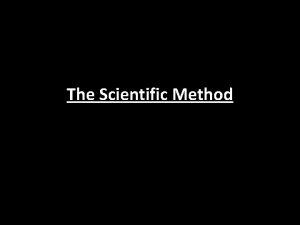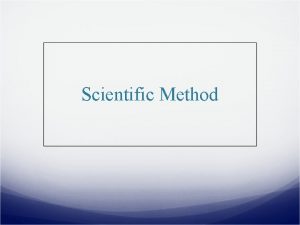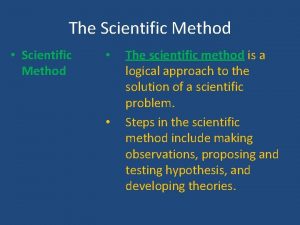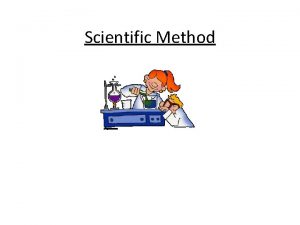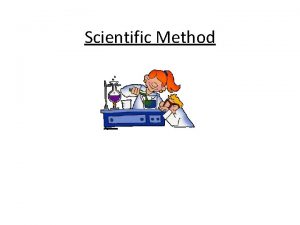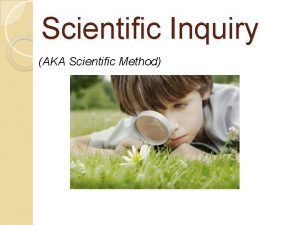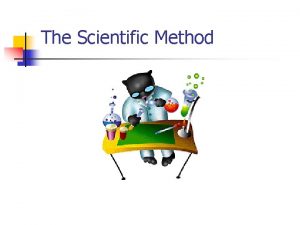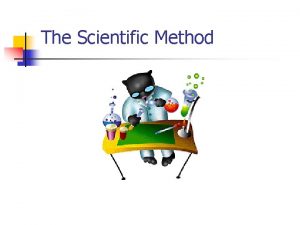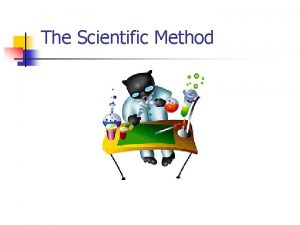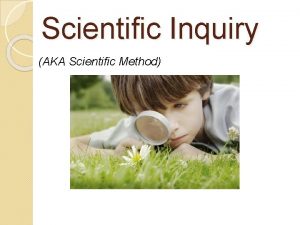Scientific Method What is the Scientific Method The



















- Slides: 19

Scientific Method

What is the Scientific Method? • The scientific method is a logical, problem solving technique.

Steps of the Scientific Method • Observation • Problem Statement • Hypothesis Statement • Experiment / Data Collection • Conclusion Statement

Observation • The scientific method begins with observation • An observation is a visible or provable fact. • An inference is an opinion, or conclusion, based on observed facts.

Observation vs. Inference Observation: Inference:

Observation vs. Inference Observation: Inference:

Problem Statement • Careful observations lead to questions that arise. • A problem statement is a question that compares variables. – Example: Does the drop height affect the bounce height of a superball?

What are Variables? • A variable is something that changes. – There are independent variables and dependent variables.

What is an Independent Variable? An independent variable is a variable that changes unrelated to other factors; a variable we manipulate, or change, on purpose. An independent variable is the variable whose value we know before we start an experiment. Example: Does the drop height affect the bounce height of a superball? We know the drop heights we will use.

What is a Dependent Variable? A dependent variable is a variable that changes depending on some other factors; the variable we are trying to find out. The dependent variable is the variable whose value we do not know before we start an experiment. Example: Does the drop height affect the bounce height of a superball? We do not know the bounce heights before we start.

What is a Constant? A constant is a variable that does not change for the duration of an experiment; a value that remains the same. Example: Does the drop height affect the bounce height of a superball? superball The superball does not change during the experiment.

Hypothesis Statement • A hypothesis statement is a statement that expresses the expected answer to the problem statement; – what you think the results of the experiment will show. • Example: If a superball is dropped from increasing heights then the bounce heights will also increase because… because

Experiment • An experiment is a planned way to test a hypothesis and find out the answer to the problem statement. • An experiment is a way to collect data and determine the value of the dependent variable. • An experiment compares the independent variable to the dependent variable. • An experiment can only test one dependent variable at a time.

Conclusion Statement • A conclusion statement is a statement that presents the findings of the experiment, what the data shows, and states if the hypothesis was correct (supported) or incorrect (negated).

Why Do We Use Graphs? • Graphs help us visualize numerical data. • There are several different types of graphs: – Bar graphs – Pie graphs – Line graphs

Bar Graphs • Bar graphs are used to show a comparison of multiple objects.

Pie Graphs • Pie graphs are used to compare the parts of a whole.

Line Graphs Line graphs are used to show the relationship between variables.

Types of Relationships (between variables) Direct: as x increases y increases Indirect: as x increases y decreases Constant: as x increases y remains the same
 Scientific inquiry vs scientific method
Scientific inquiry vs scientific method How is a scientific law different from a scientific theory?
How is a scientific law different from a scientific theory? Hình ảnh bộ gõ cơ thể búng tay
Hình ảnh bộ gõ cơ thể búng tay Lp html
Lp html Bổ thể
Bổ thể Tỉ lệ cơ thể trẻ em
Tỉ lệ cơ thể trẻ em Chó sói
Chó sói Thang điểm glasgow
Thang điểm glasgow Chúa sống lại
Chúa sống lại Môn thể thao bắt đầu bằng từ đua
Môn thể thao bắt đầu bằng từ đua Thế nào là hệ số cao nhất
Thế nào là hệ số cao nhất Các châu lục và đại dương trên thế giới
Các châu lục và đại dương trên thế giới Công thức tính độ biến thiên đông lượng
Công thức tính độ biến thiên đông lượng Trời xanh đây là của chúng ta thể thơ
Trời xanh đây là của chúng ta thể thơ Cách giải mật thư tọa độ
Cách giải mật thư tọa độ Phép trừ bù
Phép trừ bù độ dài liên kết
độ dài liên kết Các châu lục và đại dương trên thế giới
Các châu lục và đại dương trên thế giới Thể thơ truyền thống
Thể thơ truyền thống Quá trình desamine hóa có thể tạo ra
Quá trình desamine hóa có thể tạo ra























